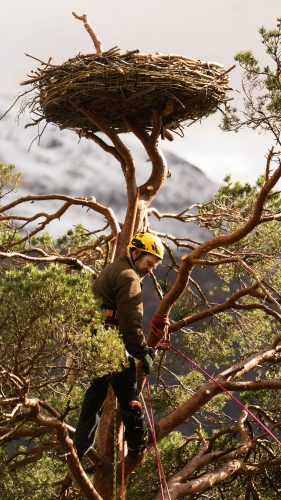BIO

I'm Iain Jenner, and I began climbing trees as a working practice in 1998, as a conservation volunteer.
For three years, I worked for an organisation called Profelis in Costa Rica, dedicated to the rehabilitation and release of arboreal wildcats, particularly Ocelots and Margays. These were confiscated from the illegal pet trade, either being smuggled across the border, or when found in the possession of people who craved an exotic pet.
Tree-climbing wasn’t a huge part of my role, but as well as helping look after cats at the project centre, I became involved in rainforest surveys to assess local wildcat populations, and radio-tracking to monitor animals that had been successfully released.
Sometimes we built camera traps that were installed on branches, or put up temporary viewing platforms in the canopy of a tall tree, to be able to get a more panoramic view over the denser growth of the forest floor.
It was exciting and fascinating work, providing insight into a hidden world of wildlife most people never see, and three years later, when I came home to Onich, I was keen to find a way to do more.
-----------
 After getting work as a self-employed gardener and groundskeeper in the local area, I did some basic chainsaw training to grow my capacity for the job, and became aware of the progression of formal arboriculture qualifications.
After getting work as a self-employed gardener and groundskeeper in the local area, I did some basic chainsaw training to grow my capacity for the job, and became aware of the progression of formal arboriculture qualifications.
As I had no formal education as a biologist or ecologist, this seemed the best route back to spending more time above ground, and included an extensive set of skills for carrying out all kinds of tree surgery. I settled into arboriculture and forestry as a profession, and alongside spells of working for UHI (Lead Lecturer in Rural Skills) and SSEN (Tree-cutting Team), have been developing this as a business since 2001.
Over twenty years, I have had numerous clients – private garden owners, hospitality businesses, crofters, farmers and large estates, organisations including Forestry Enterprise, EuroForest, BEAR Scotland and more recently, Scottish Woodlands.
It is challenging work, with no two days the same. A constant round of physical problem-solving with branches and lengths of heavy timber, usually in confined spaces. It requires a deep focus, as there is no room for error. We work by paths, roads, houses, boundaries, over rivers or next to powerlines.
You need to be fit and healthy, certain of what you’re doing, well-equipped, confident in your colleagues, and your training, which must be refreshed every few years.
----------
During the recent Covid lockdown, many of us had the chance to re-evaluate what we do for a living. I was still recovering from operations to release nerve entrapment in both hands, an unfortunate, but common side effect of working as an arborist, after spending years handling ropes and chainsaws.
I took some online courses with the Arboriculture Association, and moved into work surveying trees for the purposes of identifying hazards, to inform woodland management plans, and for mapping root systems to mitigate house development plans.
 And with the start of my professional journey in mind, as a Profelis volunteer, I have been reaching out to organisations involved with conservation, reforestation, rewilding and local communities, to diversify my work and try to reframe its emphasis in the context of the ecological crises of our time – climate change and biodiversity loss.
And with the start of my professional journey in mind, as a Profelis volunteer, I have been reaching out to organisations involved with conservation, reforestation, rewilding and local communities, to diversify my work and try to reframe its emphasis in the context of the ecological crises of our time – climate change and biodiversity loss.
There will always be a need for traditional arboriculture work.
Where there are trees in proximity to infrastructure, there will always be some creating a danger that must be removed. There will always be municipal and garden spaces requiring specimen trees to be celebrated, nurtured and pruned for aesthetic purposes.
However, working with organisations such as Woodland Trust, Arkaig Community Forest, Scotland: the Big Picture, and Kinlochleven Community Trust, I am now promoting alternative strategies to woodland management that aim to minimise habitat loss for wildlife, and even enhance it in some ways. These include tree veteranisation techniques, the installation of artificial nesting platforms and tree seed collection work.
 Most recently, I took part in training that specifically enables people who have never climbed a tree to be safely guided aloft. Soon, my intention is to be taking eco-tourist visitors, outdoor enthusiasts, artists or film crews with no experience of the canopy world above them, into the crowns of ancient trees across the Highlands to gain a genuine birds-eye view of the forest.
Most recently, I took part in training that specifically enables people who have never climbed a tree to be safely guided aloft. Soon, my intention is to be taking eco-tourist visitors, outdoor enthusiasts, artists or film crews with no experience of the canopy world above them, into the crowns of ancient trees across the Highlands to gain a genuine birds-eye view of the forest.
Between myself and the team I employ, we have cut thousands of trees over the last twenty years. Now, we’re placing a much stronger emphasis on raising the profile of the critical role trees have in an environment we all share, encouraging our clients to keep them in the landscape and use alternative methods of management wherever we can, and enable their use for positive wildlife interventions, reforestation and recreation.
